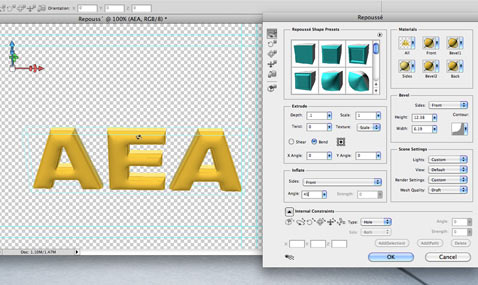As we mentioned earlier, we've been busy this year creating an extensive, multi-course video training series based on our popular beginner's book After Effects Apprentice. Each course has two or more movies that are free for all to view; we're re-posting those videos here on PVC to make sure you don't miss them. This movie explains the ins and outs of using Adobe Repouss© to create 3D objects that may then be imported into After Effects.
The eleventh Apprentice course (available both by subscription to lynda.com and stand alone from Focal Press/Class on Demand) – is a beginner-level introduction to 3D space inside Adobe After Effects. If you've never worked in 3D before, we build up your knowledge base step-by-step explaining what's different between 2D and 3D, then moving through cameras and lights – including how to build camera rigs and manage shadows. Once you've become familiar with those bedrock skills, we then demonstrate several different workflows for creating 3D objects inside Adobe Photoshop and importing them in After Effects. A set of sidebar movies at the end share additional tips on the difference between 3D rotation and orientation, using the different Axis Modes, and how to maintain maximum quality in 3D.
3D in After Effects is really what's know as “2.5D” – the layers have no actual thickness or depth. If you want the illusion of extrusion, volume, and depth, you will need to create those objects in a dedicated 3D program, a special plug-in, or – if you have access to the Production Premium or Master Collection suites from Adobe – inside Photoshop Extended to later import into After Effects. Frankly, we prefer using a dedicated program like Maxon Cinema 4D (and we've created a separate course on integrating C4D with After Effects), or using one of the excellent plug-in solutions from Zaxwerks, Boris, or Mettle (each outlined in the movie above). However, we realize many of you are in work environments where there is no budget for third-party tools, and you have to make do with what's available in one of the relevant Adobe suites. Therefore, it's worth becoming familiar with Repouss©, as it does provide an alternative.
If you've tried Repoussé and don't like it, there's hope: At this year's SIGGRAPH, Adobe and NVIDIA gave a technology demonstration of ray-traced extruded objects inside a “motion graphics environment” that looks rather like After Effects:
Fingers crossed…
FTC Disclosure: We make a bit of money whenever you purchase one of our courses from Class on Demand, or have a lynda.com subscription and watch one of our courses. We do not make any money from either when you watch these free videos. We've worked with Adobe over the years, and they give us free access to their software in exchange for testing and consulting, but they did not subsidize the creation of these videos or the book they are derived from. We're just trying to pay the bills by sharing what we've learned from using After Effects in the real world since version 1.0.
The content contained in After Effects Apprentice – as well as the CMG Blogs and CMG Keyframes posts on ProVideoCoalition – are copyright Crish Design, except where otherwise attributed.

Filmtools
Filmmakers go-to destination for pre-production, production & post production equipment!
Shop Now













